
Components
- 1 Reputation Board
- 25 House Cards
- 4 Starting House Cards
- 81 Goods Token
- 24 Outpost Cards
- 1 First-player Card
- 6 Star House Cards
- 9 Key House Cards
- 25 Cave Cards
- 7 Dice
- 10 Cider Tokens
- 20 Potion Tokens
- 1 Round Marker
- 36 Villagers
- 4 Cubes
- Coins 4 Player Boards
- 1 Encounter Book
Setup
-
Give each player a player board, seven coins, 1 starting house card, and 1 of each type of starting villager (3 villagers total for each player). The starting villagers have a house on the back of the token. The 3 villagers should have the symbols depicted at "1A", and start in the large grass area furthest to the left on the player board--the "ready area".
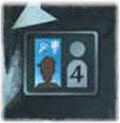
If playing with four players, place the two starting villagers that do not have a hammer symbol in the grass area with a moon symbol--the "exhausted area". (In the first round of play, each player will only be able to use one villager.
The two villagers that start in the exhausted area will move to the "ready area" at the end of round one. The symbol pictured below can be found on the reputation board next to the round track and is meant to remind you of this rule).
-
Place the 6 star house cards face up on the table in a row. Shuffle the 9 key house cards and draw 4 at random, placing them in a row, face up, below the star house cards. The remaining key house cards are placed in the box and are not used for this game.
-
Put the reputation board in the center of the table. Put any unused starting villagers in the box. Place the special villagers aside (special villagers have a triangle symbol on the back of the token). Place the remaining villagers face down in a pile and draw five, putting them along the top of the reputa- tion board in a row.
-
Place the round marker on the top chamber in the string of seven caves on the reputation board.
-
Place the coin tokens, good tokens, cider tokens, and potion tokens near the side. This is the supply. Place one cider token on the reputation board in the area with a cider symbol.
-
Shuffle the cave cards and place them in a pile face up next to the reputation board.
-
Give each player a wooden cube that matches the color of the banner in the top left corner of their player board. Each player places this cube on the torch space on the reputation board.
-
Decide who will be the first player. Turn order is in clockwise direction. Give the first player the first-player card.
If playing with two players, give the second player one extra coin.
-
Shuffle the house cards and the outpost cards and place them in two piles face down underneath the reputation board. Draw the top four cards of each deck and place them face up in a row next to their respective decks.
-
Place the encounter book and dice near the play area.
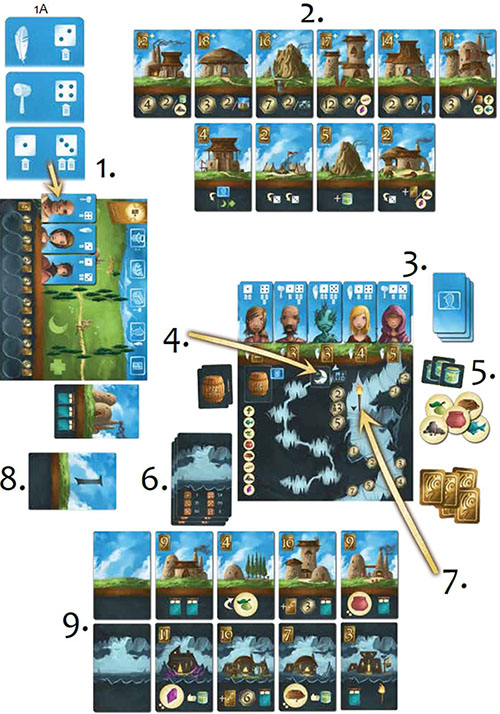
Game Play
Above and Below is played in rounds. Each round, players take turns assigning their villagers to take actions. When a player wishes to take no more actions in the round, he states that he wishes to pass. When all players have passed, the round ends (this means that some players will sometimes have more turns than others).
After seven rounds, the game is over. Perform the following steps each round.
1. Player Actions
Starting with the first player (the player with the first-player card) and continuing in clockwise order, each player may take one action per turn until all players have passed. The available actions are:
Explore

Villagers explore the cavern in an attempt to find a place for an underground outpost.
First, the player draws a cave card from the top of the cave card deck and places it to the left of his player board (near the rocks in the corner). He then slides two or more villagers from the ready area on his player board to the card (there is no limit to the amount of villagers he may send exploring, but he must send at least two).
He then rolls a die and compares it to the grid of numbers on the lower half of the new cave card-- the resulting number indicates which paragraph should be read to him from the encounter book. The player to his left turns to the indicated paragraph in the encounter book and reads it to him.
The reader reads the entire paragraph, including any choices below the description (in BOLD CAPS) AND the associated explore numbers. The only thing the reader does not read aloud are the possible rewards after each explore number (in parentheses).
An encounter paragraph might look like this
You descend a deep chasm until you reach a wide, dark chamber. Rancid, cloudy water covers the cave floor, and soon you see glowing red eyes in all directions. You raise your lantern and realize that you're surrounded by giant rats, their brown, oily coasts slick and wet. They close in, ready to make your party their next meal.
Do you try to run and hide from the rats, or do you stand and fight?
RUN AND HIDE: Explore 3 (coin), Explore 4 (mushroom) STAND AND FIGHT: Explore 7 (five coins, ore)
After reading the description, the reader describes the two available choices like this: "Run and hide-- explore 3 or 4. Stand and fight-- explore 7".
The active player then selects one of the available choices (for example: "run and hide"). He must state aloud his choice. The active player must then attempt to meet or exceed at least one of the explore numbers following that c
The active player rolls one die for each villager that was sent into the cavern (on the cave card). He must indicate for which villager he is rolling each time he rolls. Once rolled, he places the die on the villager. The amount of lanterns gained by the villager depends on the roll, as described below:
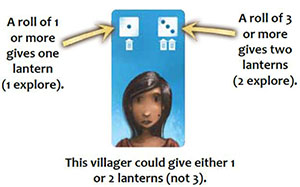
After all dice have been rolled, the active player adds the total number of lanterns from his villagers. If the total is equal to or greater than one of the explore numbers associated with his choice, he succeeds. If he does not have a sufficient number of lanterns, he may then choose to Exert one or more of his villagers to gain extra lanterns.
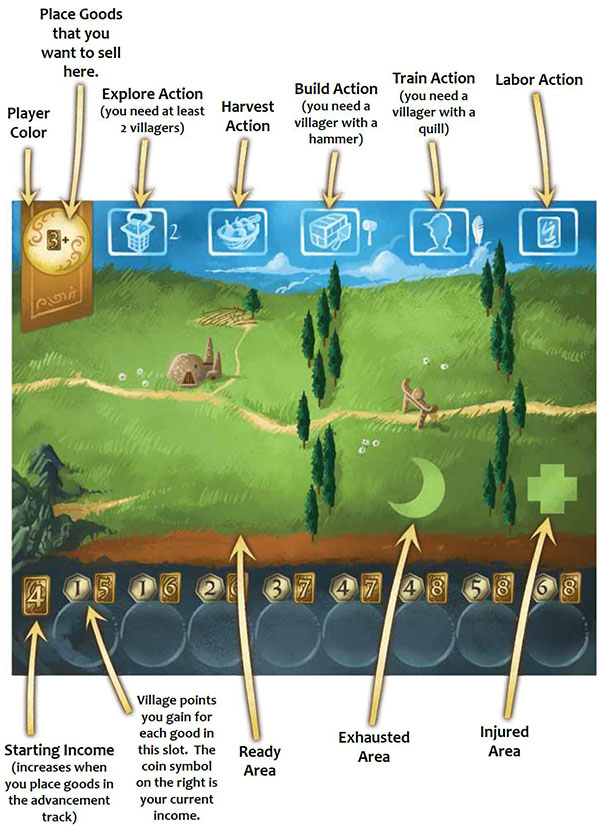
To Exert a villager, the player removes the villager from the cave card and places him or her in the injured area on his player board. Each exerted villager gives the player one extra lantern.
If the final total of lanterns meets or exceeds one of the explore numbers associated with the player's choice, he succeeds and gains the rewards from the highest reached explore number.
For example, if the player chose "run and hide" from the explore paragraph on page six, and he rolled a total of 5 lanterns, he would gain the reward from "Explore 4", a mushroom.
After the player gains the reward, he moves any villagers remaining on the cave card to the exhausted area on his player board. He places the cave card to the right of his player board, underneath his row of houses, in the same row as other cave cards and outposts he already owns.
If the player does not have enough lanterns to meet or exceed at least one of the explore numbers associated with his choice, he fails and does not gain the cave card or any rewards. He moves any villagers remaining on the cave card to the exhausted area of his player board and puts the cave card at the bottom of the cave card deck. Some paragraphs have failure descriptions, and must be read if a player fails a specific choice. If the failure description includes a penalty, this is applied to the player.
NOTE: For more details, read the first page of the encounter book.
Build

A villager builds a house, a star house, a key house, or an outpost.
First, the player slides one of his villagers from the ready area of his player board to the exhausted area of his player board. The villager must have a hammer symbol.
The player may then choose to purchase one of the available house cards, star house cards, key house cards, or outpost cards. He must pay an amount of coins to the supply equal to the cost of the card.
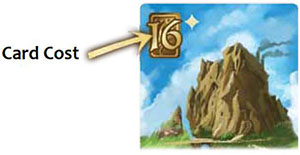
If a player wants to purchase an outpost, he must have an open, available cave card (that he gained from a previous explore action). He places the new outpost on top of the available cave card.
Houses, key houses, and star houses are placed in a row next to the starting house. Outposts are placed in a row underneath the row of houses.
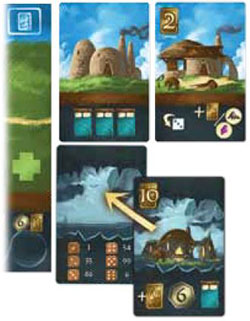
Houses, key houses, star houses, and outposts give the player a special ability, increased income, and/or other benefits. After the player has finished placing his new card, if he built a house or outpost, he then must draw a new card so that there are four available choices for the next player.
Harvest

Villagers harvest goods from houses or outposts.
First, the player slides one or more of his villagers from the ready area of his player board to the exhausted area of his player board.
For each villager the player exhausts, he may take one goods token from one of his houses or outposts. He places that good next to his coins and may either keep it there for later, place it for sale in the top left corner of his player board, or place it in his advancement track.
Train

A villager trains a new villager.
First, the player slides one of his villagers from the ready area of his player board to the exhausted area of his player board. The villager must have a quill symbol.
The player may then purchase a new villager from the reputation board. He may select any of the available villagers. He must pay the cost in coins to the supply. The cost is listed on the reputation board below each villager.
The player places the new villager in the exhausted area of his player board. The player does not draw a new villager for the reputation board. (This will be done at the end of the round).
Labor

Villagers labor to gain more coins.
First, the player slides one or more of his villagers from the ready area of his player board to the exhausted area of his player board.
For each villager the player exhausts, he gains one coin. Additionally, the first player to labor each round gains the cider token on the reputation board. If there is no cider on the reputation board, the player only gains coins.
Free Actions
Free actions can be performed on a player's turn without exhausting villagers. A player may perform as many free actions as he likes before he performs a normal action. After he performs a normal action, he may not perform any free actions.
Buy From A Player
A player may purchase a good, cider, or potion from another player that has been placed for sale in the top left corner of the seller's player board. The player may bargain, make offers, etc, but may only pay in coins, and he must pay at least 3 coins. The seller may refuse the offer for any reason. If the seller agrees to sell the good, potion, or cider, the player pays him the agreed upon amount of coins and takes the good.
Put Something For Sale
A player may place one of his goods, a cider, or a potion for sale by placing it in the circle at the top left corner of his player board. Other players may attempt to purchase it on their turns.
A player may remove the good that is for sale, or replace it with something else, only on his turn.
Refresh Building Row
If a player wants new options of houses or outposts to purchase, he may pay one coin to replace all four available cards in one of the rows. He takes the four current houses or outposts in the row and places them at the bottom of the deck, then draws four new cards from the top of the deck and places them face up in the row.
He may do this only once per turn. It is not possible to refresh the key houses or star houses.
Pass
When a player is done taking actions, he declares "I pass". He may not take any more actions or free actions in this round.
A player that does not have any villagers in the ready area of his player board at the start of his turn must choose to pass. He may take free actions before he passes.
2. End The Round
When all players have passed, the round ends. Follow these steps before the next round starts:
Round Marker
Slide the round marker one chamber down the string of seven caves on the reputation board. If the round marker cannot move, the game is over.
Cider
Place a cider on the cider icon on the reputation board if it does not already have one.
New Villagers
Slide any remaining villagers on the reputation board to the left so that they occupy the lower cost slots and replace any open slots to their right by drawing new villagers from the villager pile.
Rest Villagers
Now all players may refresh the villagers on their player boards.
First, players may spend any potions or ciders. If a player spends a potion, he may move one villager from the injured area to the exhausted area. If a player spends a cider, he may move one villager from the exhausted area to the ready area. A player may use both a potion and cider on the same villager.
Now, players may move one villager from injured to exhausted, or from exhausted to ready for each bed he has on his house and outpost cards. A villager cannot sleep in two beds (the villager wouldn't be able to move from injured to ready by using two beds).
Collect Income
Now all players collect coins based on their income level. Players start at 4 income, but their income level increases depending on the number of different goods in their advancement track at the bottom of their player board.
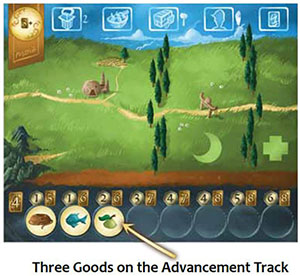
A player with an advancement track as depicted above would gain 6 income instead of 4.
Players also collect income from any house or outpost cards that give extra income.
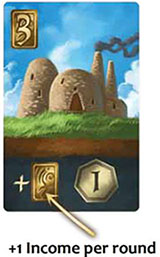
Refresh Goods On Buildings
If any player owns a house or outpost with this symbol and there is currently not a good on the card, place one of the appropriate goods there.
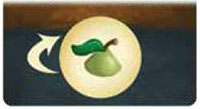
Pass First-player Card To The Left
The first player passes the first-player card to the player to his left, who places it face up in front of him.
Start The Next Round
If seven rounds have not passed, begin the next round.
Advancement Track
A player's advancement track is the row of circles along the bottom of his player board. A player may place available goods on this track at any time. He must place goods from left to right, not leaving any empty slots.
Once a good has been placed, if the player wishes to place another good of the same type, it must go on the same slot (slots can contain multiple goods of the same type). Goods can be placed in any order.
In the example below, any future fruit goods that the player chooses to place in the advancement track would have to be placed on the third slot from the left. If the player wanted to place a mushroom good next, he would have to place it in the fourth slot from the left.
There are two numbers at the top of each good slot. The left number indicates how many village points each good in that pile is worth at the end of the game. In the example below, if a player had two fruit goods at the end of the game, each of those goods would be worth 2 village points (for a total of 4 village points).
The right number above each slot is an indication of the player's current income. In the example below, the player would collect 6 coins, (listed above fruit), at the end of each round (he would not also collect the coins listed above any of the other goods-- only the good furthest to the right).
Once a good has been placed in the advancement track, it cannot be removed.
Special Villagers
There are six special villagers in the base game. They are the Liquid Woman, Glogo, Cave Cat (two of these), and Metal Man (two of these) villagers. At the start of the game, place these villagers face up near the play area. They can only be obtained through specific encounters in the explore book. Each of these villagers has special rules.

Liquid Woman: The liquid woman is unsettling. When she joins your village, you lose one reputation.

Glogo: The glogo is adept at building. If you use him to build, pay one fewer coin than normal.

Cave Cat: The cave cat doesn't like to obey orders. Each time you use the cat you must roll a die. If you roll a 3-6, the cat will perform the task you assign it. If you roll a 1-2, the cat moves to the exhausted area without performing any task.
If the cave cat does not perform the task, you do not lose your action this turn. You may exhaust another villager to perform an action.

Metal Man: The metal man uses his own bed each day. He cannot use beds on your buildings. He cannot use cider or potions.
Reputation
The reputation track is a measure of how well-known and esteemed a player's village is. All players start on the torch symbol on the track. If a player gains reputation, he moves his cube down the track, toward the bottom of the cave. If a player loses reputation, he moves his cube up the track, toward the surface.
End of the Game
After seven rounds have passed, the game ends and players count up village points. Players gain village points for the following:
Advancement Track
Players count up village points for each goods token on the advancement track. The amount each token is worth is indicated just above the slot on the board. In the example below, if a player had four fruit on the third slot, he would gain 2 village points each for a total of 8 village points.
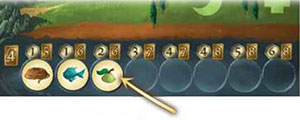
Buildings
Each building is worth 1 village point. This includes houses, key houses, star houses, and outposts. This does not include empty cave cards a player owns.
Reputation
At the end of the game, the player with the most reputation gains 5 extra village points. The player with the second-most reputation gains 3 extra village points. The player with the third-most reputation gains 2 extra village points. If playing with two players, only the player with the most reputation gets the bonus: he gains 3 points (this is why there is a person symbol with the number "2" in this village point symbol).
Players also gain or lose village points indicated by a smaller village point symbol next to their position on the track.
For example, if a player ended the game with his cube on the highest space on the track, near the surface, he would lose 2 village points.
Card Bonuses
Some buildings give bonus village points. In many cases, the points are simply listed at the bottom of the card. The card below would give the player 2 bonus village points.
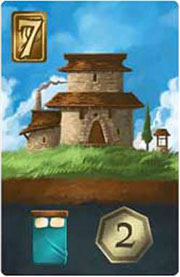
Some cards give bonus village points for owning specific things. The card below on the left would give a player 4 bonus village points, plus 2 bonus village points for each potion or ore he owns (the ore can be in the advancement track or simply in the player's supply--not on a building). The card below on the right would give a player 3 bonus village points, plus 2 points for each house/key house/star house he owns.
Remember: each of these cards also gives 1 village point in addition to bonus points, because they are buildings.
Compare Total
Players compare their total village points. The player with the most village points is the winner! If tied, the player with the most coins wins the tie. If still tied, the player with the most villagers wins the tie. If still tied, the player with the most buildings wins the tie.
Continue Reading
